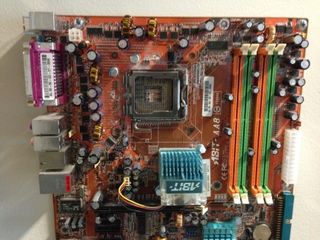Why you can trust TechRadar
The 10-megapixel camera on the Moto X might be, no, definitely is, the most inconsistent snapper on a flagship phone. One moment it takes a shot on par with the two of the best phone cameras we've used, the iPhone 5 and the Galaxy S4. Then you move slightly to the right or aim up a little, and it completely misjudges the light in the room and takes a horribly underexposed shot. It's maddening.
It's also a bit low on options, at least compared with the Galaxy S4. It does have a slick interface though, letting you swipe from the left to bring up an option wheel, and swipe from the right to bring up the gallery and cycle through your shots. You can also set HDR to kick in automatically, not that the Moto X does a great job of knowing when it's necessary, so you might end up with that weird haloing effect more often than you think.
At least the Moto X shoots extremely fast, and has a touch to focus and shoot feature. That means you just touch a point on the screen to snap a pic, and keep holding for as long as you'd like it to shoot. Surprisingly, that doesn't seem to help it judge the exposure at all.
There's no way to manually adjust the exposure. You can't bump up the ISO, and the touch to shoot only controls focus, not exposure. That's tragic on a phone that's so bad at judging light.
At least the interface is clever and functional. The camera can be accessed by twisting the phone 180 degrees twice. Do that when the phone is active or locked, and you can feel a whirring within the Moto X and boom, you're ready to take a shot. It's fast, accurate, a great way to avoid missing a Kodak moment, and only makes you look slightly silly when you do it, like you're trying to shake a bug off your phone.
Update: When we first reviewed the Moto X, our biggest issues was with the camera performance. It's now been significantly updated with better point and shoot performance as well as some manual focus and exposure control. We've added a new sample gallery below where we've taken the same shot first on the Moto X, then on an iPhone 5. You'll find our original crop of samples at the bottom of the page.


I took this shot using the Moto X's manual exposure targeting. In both shots I metered for the wall on the right. While neither picture is beautiful the Moto X did a great job of balancing the light in the shot. The back windows aren't as blown out as in the iPhone shot and carpet is as dulled by shadows. Nice work, camera update!


Unfortunately the Moto X still takes shots with tons of color noise, and can blow out backgrounds if you don't meter precisely. Note the duller, fuzzier colors on the Moto X sample, as well as on the wall behind it, which is blown out to white. The iPhone 5 gets closer to its actual off-white, eggshell color.
Moto X vs iPhone 5 camera samples


All around brighter colors from the iPhone 5. The wood table top looks especially dull in the Moto X shot.


Again the iPhone 5 beats the Moto X for color reproduction. There's more yellow to the cookie on on the iPhone's shot, whereas the Moto X makes it look like a washed out brown.


More dull, fuzzy colors from the Moto X.


It's dull reds and fuzzy skin tones on the Moto X for this menagerie of Marios.
Summing up the new samples: I do realize that I'm comparing a Moto X to an iPhone 5, a phone that costs quite a bit more, but Apple's phone has more or less set the standard for point and shoot consistency.
Also, while Motorola's new manual camera controls help, it's annoying that you have to bother with them. Motorola left them out to begin with, saying that most users don't bother with them and just want to point and shoot. That's true, but even after the camera patch, the Moto X still takes a consistently worse shot than the iPhone 5 when you don't bother to tweak.
Noisy, washed out colors are still the Moto X's biggest camera issue, and photography remains the phone's only real weak link.
Original camera samples

The Moto X's camera is capable of excellent levels of detail and decent color replications. We shot this same graffiti mural on an HTC One and a Galaxy S4 for comparison.

This is the S4's shot. Its higher megapixel count only buys it a little more detail, but it does replicate colors with a lot less noise, especially on the wood of the bench.

Here's the One's go at it. It's got duller, slightly bluer colors.

Here's a shot where you can really see the color noise. Check out the skin of the fruit.

A decent shot, but it would have been better if the X didn't set the exposure for the bright corner of the picture, rather than the subject we touched, which would be the limes.

An exceptionally bad moment of under exposing. You'd never know this was taken at three in the afternoon, on a moderately bright day.

An unattractive subject to say the least, but the X captures a pleasing level of detail, and there's only minimal noise in the gray areas of the door.

The X has no trouble getting the focus right.

Dark and night time shots are bad for any camera, but they're especially ugly on the Moto X.

The flash helps quite a bit. This is a pretty acceptable shot for a dark room.

Don't get too close with that flash though, or your subjects will look like porcelain dolls.
To further test the Moto X's low light performance, we put it up against an iPhone 5, which is an above average low light performer. Here's what we found:

Here's the Moto X's shot, with lots of blobby color noise, but it manages to be slightly sharper than the iPhone 5 image.

While still not a great shot, the iPhone's picture does better with color.

Notice how the salt in the Moto X shot is looks like a solid object.

The iPhone's attempt reveals more grains.
These next pictures are all from the Moto X. We shot the same subject twice, so you can see how wildly inconsistent the Moto X's judging of exposure can be.


As you can see in the first photo, the camera automatically metered for the sky and scene outside the windows, and our subject is underexposed. For some reason, in the second photo, the exposure is a little more balanced, but our subject is still slightly underexposed.


A few more samples from the Moto X:







Bottom line, the Moto X can take a great picture, it just doesn't always decide to do so. While the color noise is pretty steady, the pictures are all in focus, which is great. The weak link is really the phone's inability to judge exposure properly.
This is all especially frustrating because the camera has some great interface features. The activation gesture works really well, and having auto HDR is nice. The interface is slick and it shoots quickly. I just wish having a touch to shoot feature that accounts for exposure could have helped the Moto X.
The hardware is capable, but the software isn't. At least that's something that could be fixed with a patch, or just using a third-part camera app.

Annual cybersecurity training isn’t working, so what’s the alternative?

How manufacturers can create a sustainable business model

Getting ChatGPT to run on a NAS is actually worth exploring — tech enthusiast puts an Nvidia RTX GPU in a 12-bay NAS powered by an AMD EPYC CPU, and the results are surprising
